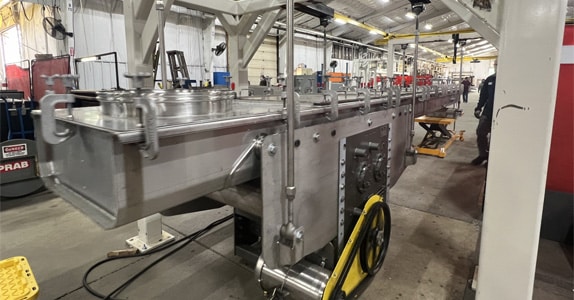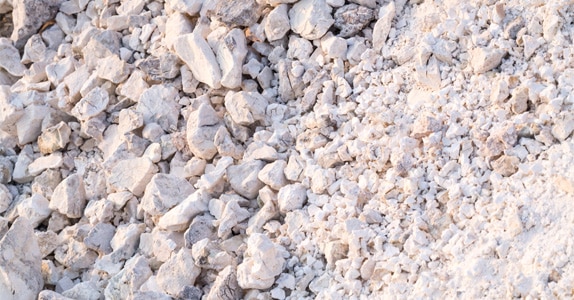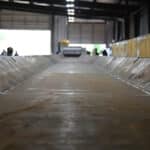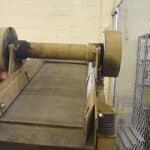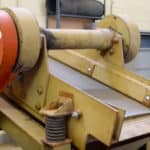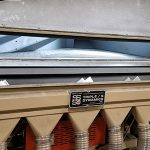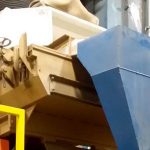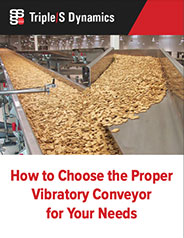Answers To 12 Common Questions About Horizontal-motion Conveyors
A horizontal-motion conveyor can smoothly and efficiently move a huge variety of materials, such as polymers, hot potash, borax crystals, potato chips, and breakfast cereal, without damaging, segregating, stratifying or aerating them. This article answers common questions about horizontal-motion conveyors and how to apply them.
The horizontal-motion conveyor (also called a horizontal differential-motion conveyor, differential motion conveyor, or differential conveyor) uses a two-cycle slow-advance-quick-return motion to smoothly convey any free-flowing bulk material horizontally. The conveying surface, which can be an open pan or a fully closed conduit, is a seamless, one-piece unit. During the advance cycle, the conveying surface moves slowly forward. As it does, the material remains at relative rest on the conveying surface, even as it’s being moved forward. During the return cycle, the conveying surface moves quickly back to its original position and slips beneath the material, in much the same way as a tablecloth that’s quickly jerked out from under a table setting. This differential action is continually repeated, giving the horizontal-motion conveyor the ability to smoothly convey materials as fast as 40 fpm over distances up to 200 feet.
Along with the differential motion, the horizontal-motion conveyor’s overall mechanical simplicity gives the conveyor several advantages over other conveyors, such as vibrating, drag, belt, screw, and pneumatic conveyors. The horizontal-motion conveyor has no moving parts other than its scaled drive unit. This reduces safety risks and simplifies cleaning and maintenance.The conveyor also has intrinsic advantages for applications that require dust control reliable and gentle handling of fragile materials. and more .The following questions and answers provide more detailed information about the horizontal-motion conveyor’s capabilities and applications.
1. Can the horizontal-motion conveyor transport materials at an incline?
Yes. Although the horizontal-motion conveyor is more commonly used in horizontal applications, it can also be used in applications that require transport at a slight incline or decline. The physical characteristics of the material being moved determine the practical incline. Some particle shapes will convey better up inclines than others. For example, round or spherical particles tend to roll and lose conveying energy on inclines.
When transporting fine material at an incline, material traces might be left behind on the conveyor pan at the production run’s end, requiring the pan to be cleaned. However, the conveyor can he equipped with pan-cleaning devices to handle this problem.
Finally, the material travel rate and resulting conveyor capacity will also be lower when conveying material at an incline. The drop in capacity call he countered by increasing the conveyor’s operating stroke or pan width.
2. Can this conveyor handle a change in directional flow?
When properly configured, the horizontal-motion conveyor can be used to convey either forward or backward – but only in one direction at a time. Reversing the drive motor’s voltage polarity through the motor ‘s starter will reverse the now direction, which can be useful in many applications. For example, say you want to package a material in both 50- and 100-pound bags. You could set up the horizontal-motion conveyor so that the material was delivered to the conveyor’s midsection . By reversing the flow direction, you can then use the same conveyor to deliver material to bagging stations at each end of the conveyor. It’s also possible to equip the horizontal-motion conveyor with an optional online reversing mechanism that allows it to reverse flow nearly instantaneously.
3. Can the horizontal-motion conveyor be totally sealed?
Whether you need to control dust, provide pressure isolation, blanket your material with an inert gas, or provide other environmental controls, the horizontal-motion conveyor is readily adaptable. You can equip the conveyor with a totally enclosed conduit instead of an open conveyor pan. The conveyor can also have both a scaled section and a separate section (or sections) open to the upstream or downstream process (or both processes).
The horizontal-motion conveyor can also he adapted for applications that don’t require a totally scaled system but still need some dust control or isolation from the plant environment.
An open-pan horizontal-motion conveyor can be fitted with a cover (with cleanout ports, if needed). Inlet and outlets between two conveyors or between a conveyor and another machine can be connected using a standard flexible boot connect ion or, because of the unique sliding action of the horizontal-motion conveyor, by very closely mating the conveyor pan to the other conveyor or machine. The latter leaves a very small distance for the material to travel from one machine to the other, which helps control dust.
4. What if multiple inlets and discharges are required?
A single horizontal-motion conveyor can readily incorporate multiple inlets and outlets .Multiple inlets can be used to introduce materials from different storage vessels or 10 meter several materials onto one conveyor. Because of the conveyor’s slow-advance, quick-return cycling, materials neither mix nor separate during transport . If the inlets deliver blended materials, they’ll stay blended; if they introduce the material in layers, it will stay in layers.
The horizontal-motion conveyor can also be filled with multiple lanes so that a single conveyor pan and drive unit can be used to transport different materials.
One or more discharge outlets can be located at any point along the conveying section’s bottom to distribute the material. Each outlet can be filled with a mechanical discharge gate to start and stop material discharge. These gates, typically pneumatically actuated, can be slide gates, butterfly valves, or tip-style drop gates.
Individual discharge outlets can be set up to distribute variable amounts of the total flow, ranging from “all” to “none” and anywhere in between. The conveyor can also be designed to accumulate a predetermined amount of material before each discharge for an immediate delivery during demand .This capability is useful in applications such as discharging into packaging scale feeders.
5. Is this conveyor suitable for large-capacity, heavy-duty applications?
Horizontal-motion conveyors more than 200 feet long with pan widths up to 10 feet have been used successfully for many years. In applications requiring the conveyor to carry enormous loads of heavy materials such as scrap metal. structural trusses and impact beds are incorporated into the conveyor and the conveyor pan is constructed of abrasion resistant plate metal 1 inch or more thick. As a result, the conveyor can handle massive impact loads and carrying capacities. One such horizontal-mot ion conveyor weighs in at more than 350,000 pounds and its conveyor pan- 117 feet long, almost 8 feet wide, and 3 feet deep – moves more than 600,000 pounds or scrap metal per hour.
6. Can the horizontal-motion conveyor handle material being fed from a full hopper?
Yes, the horizontal-motion conveyor has tremendous load-carrying capability. Some units can convey much as two to three times their own empty weight. Unlike a vibrating conveyor, the horizontal-motion conveyor isn’t “detuned” by typical increases in material loading on the conveyor pan.What’s more, because it isn’t a “tuned” system, the horizontal -motion conveyor can be operated at variable speeds to control the material’s travel rate.
7. Can this conveyor be used to meter product?
A properly designed horizontal-motion conveyor can be setup to accept material from a full hopper and meter it without any intermediate equipment, such as a rotary valve.The discharge rate can be controlled by varying the conveyor’s motor drive speed . Because the conveyor can handle deep material bed loads, the conveyor pan can also function as a self-discharging storage unit.
In addition to metering material, the horizontal-motion conveyor can he equipped to provide product aligning, singulating (separating multiple rows of individual products or pieces from a mass), or deshingling (producing a single layer of product from a mass or stack of product). For example, a food processor making chocolate-covered pretzel s was using a vibrating conveyor in its production line. The vibrating conveyor – which uses a vertical pitching motion to move material forward – was shingling (stacking) the pretzels. However, the processor had to assign several operators to manually align and deshingle product downstream from the conveyor. By replacing the vibrating convey or with a horizontal-motion convey or equipped with aligning lanes and special deshingling ramps, the processor reduced labor costs and increased productivity. What’s more, the new conveyor significantly reduced the number of pretzels damaged by shingling.
You can further regulate discharge from the conveyor pan by installing pneumatically actuated dams or manually adjustable now baffles on the conveyor to accumulate and meter material to other downstream equipment. When equipped with dams or baffles, the horizontal-motion conveyor’s gentle motion eliminates product degradation and enables the conveyor to accumulate large amounts of material like snack foods or breakfast cereals behind the dams and baffles.
8. Will the horizontal-motion conveyor work well with abrasive material?
Yes; in fact, the horizontal-motion conveyor per forms much better than a vibrating conveyor in terms of maintenance and overall conveyor wear. A vibrating conveyor’s motion presses the pan against the material, inducing a gouging action that abrades the pan surface. Abrasive wear to the horizontal -motion conveyor ‘s conveyor pan is two to four times less than that in a vibrating conveyor.
Recently, an industrial mineral s producer was looking for a conveyor to handle fine, abrasive rock. The producer’s major concerns were dust control and limiting conveyor downtime for maintenance resulting from abrasive wear. A horizontal-motion conveyor was designed for this application with a fully enclosed conveyor pan with integral dust covers and was constructed of an abrasion-resistant material with a Brinell hardness number of 400. Dust emissions were eliminated and, after 14 months of operation, the conveyor pan showed an average surface wear of just 0.010 inch. The only maintenance the conveyor requires is periodic lubrication.
In another application, a ceramic parts producer had a different problem: The dust generated from a cutting process was causing the bearings on the producer ‘s existing belt conveyor to fail quickly. Maintenance access to the bearings, which ran the length of the belt conveyor, was difficult and cumbersome .The producer replaced the belt conveyor with a horizontal-motion conveyor. Because the conveyor’s entire drive unit could be located at the conveyors end and is enclosed, the unit’s moving parts aren’t exposed to dust. The drive unit is also much easier to access and requires less frequent maintenance service.
The horizontal-motion conveyor can also be adapted for transporting chemically corrosive materials, such as chlorinated bleach powder, by fabricating the conveyor pan from a corrosion-resistant material, like titanium.
9. Can moist or sticky materials be conveyed on the horizontal-motion conveyor?
The horizontal-motion conveyor will work for a moist or sticky material, provided you use the right materials for the conveyor pan or use a liner with it. For example, for some materials, such as powdered dish-washing detergent, a conveyor pan liner made of ultrahigh-molecular-weight polyethylene will prevent sticky particles from adhering to the surface.
10. What about application in which the conveyor will be exposed to very high or very low temperatures?
The horizontal-motion conveyor is highly adaptable and can be operated across an extremely wide range of temperatures. In some applications, air or water cooling systems have been used to enable a horizontal-motion conveyor to reliably handle hot materials up to 1,700°F.
11. Can the horizontal conveyor be easily cleaned?
This question comes up often, especially from processors in the food industry and other industries in which sanitation is of utmost importance. Because of the way it’s constructed, the horizontal-motion conveyor is typically much easier to clean than other conveyors.
Because the horizontal-motion conveyor commonly consists of a one-piece, seamless conveyor pan riding on suspension points spaced periodically along its length, both the pan’ s interior and exterior surfaces can he easily accessed for wipe-down cleaning .There are no support frames or springs under the conveyor pan (which would introduce cracks, crevices, and other dirt-holding surfaces) that need to be cleaned. The material’s gliding action over the conveyor-pan surface discourages material buildup. In fact, the material’s continuous sliding action on the conveyor’s surface typically scours the pan clean. As a result, less cleaning time is required between production cycles than with other conveyors.
When the horizontal-motion conveyor is totally enclosed (in either a rectangular or tubular shape), the unit is equipped with a clean-in-place (CIP) system. The CIP system uses water nozzles located at intervals along the conveyors length so an operator can wet-clean the interior between production runs.
12. Is this conveyor energy efficient?
Very much so. The horizontal-motion conveyor uses less energy than a slider-belt conveyor and substantially less than a screw conveyor. The horizontal -motion conveyor is very competitive with roller-belt, vibrating, and drag conveyors in energy consumption.
One reason the horizontal-motion conveyor is so energy-efficient is that the drive motor, which is sized to start the drive, typically draws a full power load only during start-up. The rest of the time, the motor usually runs at 50 percent or less of its rated capacity. (For most materials, the motor load is independent of the amount of material conveyed.) The exception is for applications that require conveying very heavy materials, like scrap steel or castings. Then, increasing material loads will increase the motor’s amp draw.


